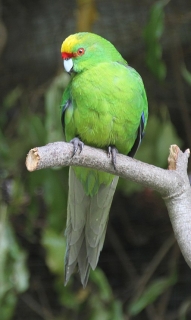Yellow-fronted Parakeet |
|
|
Also known as: Yellow-fronted Kakariki, Yellow-crowned Parakeet or Kakariki, Yellow-fronted New Zealand Parakeet
Photos
View in GalleryDid You Know?
Another name for this parrot, kakariki, is Maori for 'small parrot.'Academic Research
Related publications: Cyanoramphus auricepsSpecies Profile
Genus: Cyanoramphus | Species: auriceps
Size:
23cm (9 in)
Weight:
95g (3.3 oz)
Subspecies including nominate:
one
Colour Adult:
Both adults in general green; red frontal band reaching to eye; golden crown; red patch on each side of rump; purple/blue outer webs of flight feathers. Bill silver/grey with black tip. Eye orange/red.
Colour Juvenile:
As in adults but with shorter tail. Eye pale brown.
Call:
Calls made in flight are repetitve, quieter and more high-pitched than calls of Red-fronted Parakeet (C. novaezelandiae).
Listen NowVideo Links:
Video 1 | Video 2More Information:
Content Sources:
CITES
Wikipedia
BirdLife International
Cornell Lab of Ornithology/Birds of the World
Parrots: A Guide to Parrots of the World, Juniper and Parr, 1998
ML Media Collection Catalogue 8503, Yellow-fronted Parakeet Cyanoramphus auriceps, Loetscher, Fred W., Jr., New Zealand, Sep. 14 1968, Cornell Lab of Ornithology. Site
Parrots: Status Survey and Conservation Plan 2000-2004, Snyder, McGowan, Gilardi and Grajal, 2000.
Parrots of the World, Forshaw and Cooper, 1977. 2010 edition
Parrots of the World, Forshaw, 2006.
Lexicon of Parrots, Thomas Arndt.
Parrots in Aviculture, Low, 1992.
Photos
View in GalleryDid You Know?
Another name for this parrot, kakariki, is Maori for 'small parrot.'Academic Research
Related publications: Cyanoramphus auricepsSpecies Care
Captive Status:
Common, particularly in Australia.
Longevity:
More than 10 yrs.
Housing:
Walk-in enclosure, minimum length 3m (9.8 ft).
Diet:
Small seed mix such as: millet, canary, and smaller amounts of oats, buckwheat, safflower and a little hemp; limited sunflower seed; spray millet; green leaves such as: Swiss chard, lettuce, kale, dandelion, sowthistle, chickweed; seeding grasses; rearing food made from: hardboiled egg, wholegrain bread and carrot, all ground to crumbly consistency; fruit may be offered; complete kibble.
Enrichment:
Provide seeding grasses for foraging; also bird-safe, unsprayed flowering, pine, fir, willow and elder branches. Provide shallow water bowls or overhead misters for bathing.
Nest Box Size:
Vertical box 8" x 8" x 14" (20.3cm x 20.3cm x 35.5cm).
Clutch Size:
5-10
Incubation Time:
19 days
Fledging Age:
5-6 weeks
Hatch Weight:
Not recorded.
Peak Weight:
Not recorded.
Weaning Weight:
Not recorded.
Photos
View in GalleryDid You Know?
Another name for this parrot, kakariki, is Maori for 'small parrot.'Academic Research
Related publications: Cyanoramphus auricepsSpecies Wild Status
World Population:
10,000-30,000
IUCN Red List Status:
Near Threatened
CITES Listing:
Appendix II
Threat Summary:
Threats to this species include deforestation, habitat change and introduced mammalian predators such as stoats, rats and cats.
Range:
New Zealand and its offshore islands, and Auckland Islands.
Habitat:
Found up to 1250m (4100 ft) in lush mountain native forest with Nothofagus and Podocarpus trees.
Wild Diet:
Feeds on shoots, buds and berries; flowers of Senecio, Hymenanthera, Phormium and Coprosma and seeds including Pseudopanax, Leptospermum and thistles, as well as scale insects including Ultracoelostoma assimile and Heliostibes vibratrix caterpillars.
Ecology and Behaviour:
Usually seen in pairs or small groups feeding in the middle or upper storey of the forest as well as larger shrubs. On offshore islands where there are less threats these birds will feed on the ground more frequently.
Clutch and Egg Size:
5-10 broadly elliptical eggs, 23.0 x 19.0mm (0.9 x 0.7 in).
Breeding Season:
Usually from October-December, but may occur year-round; nest is in hollow limb or tree trunk.
Related Links:
Research: Monitoring Yellow-crowned Parakeets
TerraNature: New Zealand Ecology - Yellow-crowned Parakeet
Photos
View in GalleryDid You Know?
Another name for this parrot, kakariki, is Maori for 'small parrot.'Academic Research
Related publications: Cyanoramphus auricepsMembers Only Resources
Please log-in now to find more research, resources and tools.
Not a Member?
Find more great information:
Gain exclusive access to 600+ pages of additional research, seminars and podcasts, specialists to ask your toughest questions, and dozens of other fun resources - when you become a WPT member.
Join Today >>

































